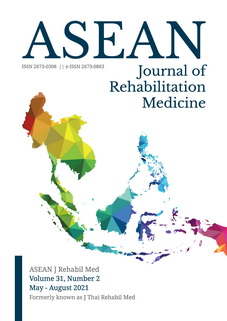Translation, Cross-Cultural Adaptation, Reliability and Validity of the Thai Version of the Trunk Impairment Scale 2.0
Keywords:
trunk assessment, stroke, reliability, validity, disability evaluationAbstract
Objectives: This study aimed to translate the Trunk Impairment Scale 2.0 (TIS-2.0) into Thai language and to test its reliability and validity.
Study design: Descriptive cross-sectional design.
Setting: The Thai Red Cross Rehabilitation Center, Thailand.
Subjects: Forty-seven stroke patients (33 males and 14 females) who received rehabilitation.
Methods: A cross-cultural adaptation process was used to translate TIS-2.0 to Thai version (TIS-TH). Four assessors with differing years of work experience scored the patients using the TIS-TH, evaluating from the video record 2 times with a 2-week interval. The results were analyzed by Cronbach’s alpha for internal consistency. Testing of intra-rater and inter-rater reliability was analyzed by Intraclass Correlation Coefficient (ICC). Spearman’s Rank Correlation Coefficient was used to test validity between the TIS-TH and the Berg Balance Scale (BBS), the Motor Assessment Scale (MAS, sitting balance subscale), and the Functional Reach Test (FRT).
Results: The TIS-TH had good internal consistency. Cronbach’s alpha was 0.823. The reliability of inter-rater and intra-rater were 0.885 (95% CI: 0.763-0.941) and 0.951 (95% CI: 0.927-0.971), respectively. Spearman’s Rank Correlation Coefficient between the TIS-TH and the three other measures the BBS, the MAS and the FRT were 0.800, 0.710 and 0.731, respectively.
Conclusion: The TIS-2.0 Thai version was acceptable, reliable and valid for evaluating trunk control in stroke patients. It could be one of disability evaluations that health care personnel in Thailand can apply in clinical practice.
Keywords: trunk assessment, stroke, reliability, validity, disability evaluation
References
Isho T, Usuda S. Association of trunk control with mobility performance and accelerometry-based gait characteristics in hemiparetic patients with subacute stroke. Gait Posture. 2016;44:89-93.
Ikai T, Kamikubo T, Takehara I, Nishi M, Miyano S. Dynamic postural control in patients with hemiparesis. Am J Phys Med Rehabil. 2003;82:463-9.
Sorrentino G, Sale P, Solaro C, Rabini A, Cerri CG, Ferriero G. Clinical measurement tools to assess trunk performance after stroke: a systematic review. Eur J Phys Rehabil Med. 2018;54:772-84.
Sullivan JE, Crowner BE, Kluding PM, Nichols D, Rose DK, Yoshida R, et al. Outcome measures for individuals with stroke: process and recommendations from the American Physical Therapy Association neurology section task force. Phys Ther. 2013;93:1383-96.
Verheyden G, Nieuwboer A, Mertin J, Preger R, Kiekens C, De Weerdt W. The Trunk Impairment Scale: a new tool to measure motor impairment of the trunk after stroke. Clin Rehabil. 2004;18: 326-34.
Verheyden G, Kersten P. Investigating the internal validity of the trunk impairment scale (TIS) using rasch analysis: the TIS 2.0. Disabil Rehabil. 2010;32:2127-37.
Suwanwela NC. Stroke epidemiology in Thailand. J Stroke. 2014; 16:1-7.
Verheyden G, Nieuwboer A, Van de Winckel A, Weerdt WD. Clinical tools to measure trunk performance after stroke: a systematic review of the literature. Clin Rehabil. 2007;21:387-94.
Beaton DE, Bombardier C, Guillemin F, Ferraz MB. Guildeline for the process of cross-cultural adaptation of self-reportmeasures. Spine. 2000;25:3186-91.
St-Pierre C, Dionne CE, Desmeules F, Roy JS. Reliability, validity, and responsiveness of a Canadian French adaptation of the Western Ontario Rotator Cuff (WORC) index. J Hand Ther. 2015;28:292-9. doi: 10.1016/j.jht.2015.02.001.
Turner R, Carlson LA. Indexes of item-objective congruence for multidimentional items. Int J Test. 2003;3:163-71. doi: 10.1207/S15327574IJT0302_5
Cabanas-Valdés R, Urrútia G, Bagur-Calafat C, Caballero-Gómez FM, Germán-Romero A, Girabent-Farrés M. Validation of the Spanish version of the Trunk Impairment Scale Version 2.0 (TIS 2.0) to assess dynamic sitting balance and coordination in post-stroke adult patients. Top Stroke Rehabil. 2016;23:225-32. doi: 10.1080/10749357.2016.1151662.
Portney LG, Watkins MP. Foundations of clinical research: applications to practice. 3rd ed. Norwalk: Appleton and Lange; 1993. 35-821.
Andresen EM. Criteria for assessing the tools of disability outcomes research. Arch Phys Med Rehabil. 2000;81:S15-20.
Sag S, Buyukavci R, Sahin F, Sag MS, Dogu B, Kuran B. Assessing the validity and reliability of the Turkish version of the Trunk Impairment Scale in stroke patients. North Clin Istanb. 2019;6:156-65.
Lombardi B, Orioli A, Casavola D, Paci M. The Italian version of the Trunk Impairment Scale: development and psychometric properties. Eur J Phys Rehabil Med. 2017;53:516-20.
Gjelsvik B, Breivik K, Verheyden G, Smedal T, Hofstad H, Strand LI. The Trunk Impairment Scale–modified to ordinal scales in the Norwegian version. Disabil Rehabil. 2012;34:1385-95. doi: 10.3109/09638288.2011.645113.
Ko J, You Y. Reliability and responsiveness of the Korean Version of the Trunk Impairment Scale for stroke patients. J Korean Phys Ther. 2015;27:175-82.
Yesil R. Validity and reliability study of the scale for determining the civic-mindedness levels of teaching staff. J Educ Train Stud. 2017;5:44-53.
Monticone M, Ambrosini E, Verheyden G, Brivio F, Brunati R, Longoni L, et al. Development of the Italian version of the trunk impairment scale in subjects with acute and chronic stroke: cross-cultural adaptation, reliability, validity and responsiveness. Disabil Rehabil. 2019;41:66-73.
Post MW. What to do with “moderate” reliability and validity coefficients? Arch Phys Med Rehabil. 2016;97:1051-2.
Liao C-F, Liaw L-J, Wang R-Y, Su F-C, Hsu A-T. Electromyography of symmetrical trunk movements and trunk position sense in chronic stroke patients. J Phys Ther Sci. 2015;27:2675-81.
Downloads
Published
How to Cite
Issue
Section
License
Copyright (c) 2021 ASEAN Journal of Rehabilitation Medicine

This work is licensed under a Creative Commons Attribution-NonCommercial-NoDerivatives 4.0 International License.






